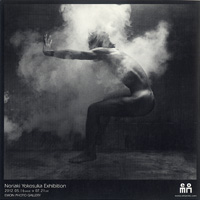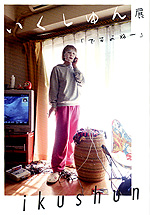 |
Picks is a monthly sampling of Japan's art scene, offering commentary by a variety of reviewers about exhibitions at museums and galleries in recent weeks, with an emphasis on contemporary art by young artists. |
 |
 |
|
|
 |
 |
|
| A Nightmare Is a Dream Come True: Anime Expressionist Painting |
| 26 May - 21 June 2012 |
Kaikai Kiki Gallery
(Tokyo) |
 |
| Takashi Murakami, who runs the Kaikai Kiki Gallery, served as curator for the show, which features the anime-inspired artists JNTHED, Mr., NaBaBa, oguchi, STAG, and hiruki. The presentation can be viewed as one answer to a question Murakami has posed for some years: "How can we fuse otaku culture with contemporary art, create a landing pad for its arrival on the western art scene, and grant this hybrid universality?" Here the solution offered is anime- and manga-inspired imagery painted by hand on canvas, not digitally produced. Ten years ago such ambitions might have been dismissed as nonsense, but now they actually seem realistic. |
|
|
 |
 |
 |
|
| Gendaibijutsu Nitouhey 20th Anniversary Dabijutsu Great Exhibition |
| 13 - 25 July 2012 |
HEP HALL
(Osaka) |
 |
| This retrospective commemorates two decades of work by the art duo Gendaibijutsu Nitouhey (lit. "Private Second-Class Contemporary Art"), consisting of Shane Kagotani and Katsuhito Fujiwara. If there is a place for "cheap candy" (dagashi), they proclaim, why not "cheap art" (dabijutsu)? Over 100 of their playful works fill the gallery, ranging from Kokeshi dolls that double as dumbbells to a traditional samurai doll wearing a Jason mask. |
|
|
|
|

|
 |
 |
 |
 |
| Noriaki Yokosuka Exhibition |
| 16 May - 21 July 2012 |
Emon Photo Gallery
(Tokyo) |
 |
| Nearly a decade has passed since the death of the brilliant photographer Noriaki Yokosuka (1937-2003). With contemporaries like Daido Moriyama and Nobuyoshi Araki still alive and active, one can't help feeling that Yokosuka died too young. A well-deserved retrospective of his best work from the 1970s and 1980s, this show is a poignant reminder of what we have lost. |
|
|
 |
 |
 |
| Shiho Sato, Yugo Hatakeyama, and Masaru Hitomi: Willpower, Percolation, and Outlines |
|
|
Ricoh Photo Gallery Ring Cube
(Tokyo) |
 |
| Held in tandem with last July's Higashikawa International Photo Festival in Hokkaido, the Ricoh Portfolio Audition bestowed its Grand Prix on Sapporo-based Akihito Yamamoto, whose Yukioto show appeared at Ricoh's Ring Cube gallery on the Ginza in November and December. But there were three runners-up -- Shiho Sato, Yugo Hatakeyama, and Masaru Hitomi -- whose work was so uniformly excellent that the judges decided to give all three a joint exhibition. |
|
|
|
|
|
|
|

|
 |
 |
 |
 |
| Shoji Ueda: Children the Year Around / Sand Dune Theater |
| 5 June - 1 July 2012 |
JCII Photo Salon
(Tokyo) |
 |
| The publication in 1971 of the photo book Children the Year Around brought nationwide fame to Ueda (1913-2000), who until then had been known only in his native San'in region on a remote stretch of the Japan Sea coast. The series serves as a masterful documentary of people's lives through four seasons in the San'in, as well as a poignant depiction of the glowing evanescence of childhood. This show offers an opportunity to view a selection of the best-known images from the series; interestingly, some of the prints on display reveal subtle variations on the shots in the book. |
|
|
 |
 |
| Haruko Sasakawa: case.A |
| 1 - 17 June 2012 |
Yoshimi Arts
(Osaka) |
 |
| Entering the gallery, one is confronted with a life-size photograph of a man in a hazmat suit and a haphazard jumble of items that fill the room, among them medals inscribed with the letter "A" and the symbol of the atom, and some dubious-looking equipment connected by tubes and dusty computer terminals. Closer inspection reveals that the man in the suit is protected only by an ill-fitting welder's mask, while the tubes and equipment, on the other hand, are carefully arranged in some sort of logical order. It's hard to tell whether the installation carries an anti- or a pro-nuclear message; perversely, it seems to reduce both stances to a relativist common denominator. |
|

|
 |
 |
 |
 |
|
| Nobuhiro Hanaoka: recurrence |
| 2 - 17 June 2012 |
Gallery PARC
(Kyoto) |
 |
| With sculptures of unrelated materials and motifs crammed together in unlikely combinations, Hanaoka invites us to savor his absurdist "vacuum zone of meaning." This show introduces three new works and six recent ones that point to a shift in his artistic inclinations of late. Where certain patterns repeated themselves in his previous work -- human figures with dislocated shoulders, and tubes of rice paste extruding from wooden boxes, among others -- his new creations hint at a change in approach. For one thing, many of his latest sculptures actually look like sculptures, carved entirely of wood. |
|
|
 |
 |
 |
| Without Thought Vol. 12: Washing Hands |
| 24 May - 3 June 2012 |
Axis Gallery Symposia
(Tokyo) |
 |
| Since 2000, product designer Naoto Fukasawa has been holding "Without Thought" workshops on the theme of unconscious human behavior and its relevance to design. The topic for this year's workshop was "Washing Hands." This exhibition of objects produced by the workshop showcases such products as stainless steel soap in the shape of a water faucet knob, brushes and mirrors that look like bars of soap, and hand towels decorated with icons of the aforementioned items. The clever use of hand-washing as metaphor makes this a fascinating study of the unthinking coexistence of people with everyday things. |
|
|
|
|
|
|
 |
 |
| Tomohiro Kato: LIFe IS STEEL FULL! |
| 16 June - 25 May 2012 |
Tezukayama Gallery
(Osaka) |
 |
| Kato is known for his obsession with steel: his works to date include paintings on steel plate in lieu of canvas, and a variety of daily necessities meticulously reproduced in steel down to the smallest details. This time he has made an entire tea-ceremony room out of steel -- not only the structure itself, but also the tea bowls, the whisk, the ladle, the hanging scroll, and even the flower arrangement. What is astonishing is not the thoroughness of Kato's effort, but its total lack of eccentricity. Indeed, it faithfully retains the tea ceremony aesthetic while adding an element of chic. |
|
 |
 |
 |
| ikushun Exhibition |
| 1 - 27 June 2012 |
LIXIL Gallery 2
(Tokyo) |
 |
| The photographer who calls himself ikushun has chosen to cover the gallery floor with piles of extremely ordinary snapshots in addition to those hanging on the wall. His work displays a whimsical sensibility somewhat reminiscent of Kayo Ume, but unlike Ume's it has a pronounced element of violence. His shot of the site of a car accident, for example, does not capture the bloody scene directly, but nonetheless starkly conveys the violence that always lurks beneath the surface of the quotidian. The juxtaposition of unsettling images with more conventional motifs makes this a stimulating show. |
|
|
|
|
 |
|